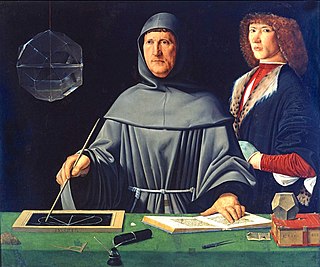
Fra. Luca Bartolomeo de Pacioli was an Italian mathematician, Franciscan friar, collaborator with Leonardo da Vinci, and an early contributor to the field now known as accounting. He is referred to as the father of accounting and bookkeeping and he was the first person to publish a work on the double-entry system of book-keeping on the continent. He was also called Luca di Borgo after his birthplace, Borgo Sansepolcro, Tuscany.

In geometry, a polyhedron is a three-dimensional shape with flat polygonal faces, straight edges and sharp corners or vertices.

In geometry, the truncated icosahedron is an Archimedean solid, one of 13 convex isogonal nonprismatic solids whose 32 faces are two or more types of regular polygons. It is the only one of these shapes that does not contain triangles or squares. In general usage, the degree of truncation is assumed to be uniform unless specified.

Piero della Francesca was an Italian painter of the Early Renaissance. To contemporaries he was also known as a mathematician and geometer. Nowadays Piero della Francesca is chiefly appreciated for his art. His painting is characterized by its serene humanism, its use of geometric forms and perspective. His most famous work is the cycle of frescoes The History of the True Cross in the church of San Francesco in the Tuscan town of Arezzo.
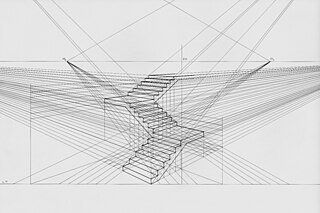
Linear or point-projection perspective is one of two types of graphical projection perspective in the graphic arts; the other is parallel projection. Linear perspective is an approximate representation, generally on a flat surface, of an image as it is seen by the eye. Perspective drawing is useful for representing a three-dimensional scene in a two-dimensional medium, like paper.

The Vitruvian Man is a drawing by the Italian Renaissance artist and scientist Leonardo da Vinci, dated to c. 1490. Inspired by the writings of the ancient Roman architect Vitruvius, the drawing depicts a nude man in two superimposed positions with his arms and legs apart and inscribed in both a circle and square. It was described by the art historian Carmen C. Bambach as "justly ranked among the all-time iconic images of Western civilization". Although not the only known drawing of a man inspired by the writings of Vitruvius, the work is a unique synthesis of artistic and scientific ideals and often considered an archetypal representation of the High Renaissance.

Sansepolcro, formerly Borgo Santo Sepolcro, is a town and comune founded in the 11th century, located in the Italian Province of Arezzo in the eastern part of the region of Tuscany.

In geometry, a flexible polyhedron is a polyhedral surface without any boundary edges, whose shape can be continuously changed while keeping the shapes of all of its faces unchanged. The Cauchy rigidity theorem shows that in dimension 3 such a polyhedron cannot be convex.
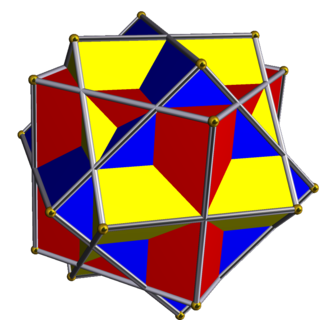
In geometry, the compound of three cubes is a uniform polyhedron compound formed from three cubes arranged with octahedral symmetry. It has been depicted in works by Max Brückner and M.C. Escher.

Divina proportione, later also called De divina proportione is a book on mathematics written by Luca Pacioli and illustrated by Leonardo da Vinci, completed by February 9th, 1498 in Milan and first printed in 1509. Its subject was mathematical proportions and their applications to geometry, to visual art through perspective, and to architecture. The clarity of the written material and Leonardo's excellent diagrams helped the book to achieve an impact beyond mathematical circles, popularizing contemporary geometric concepts and images.
Peter Forakis was an American artist and professor. He was known as an abstract geometric sculptor.

Mathematics and art are related in a variety of ways. Mathematics has itself been described as an art motivated by beauty. Mathematics can be discerned in arts such as music, dance, painting, architecture, sculpture, and textiles. This article focuses, however, on mathematics in the visual arts.
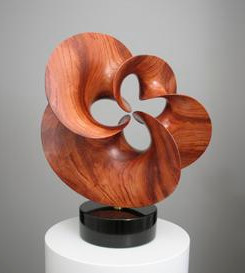
Robert Longhurst is an American sculptor who was born in Schenectady, New York in 1949. At an early age he was fascinated by his father's small figurative woodcarvings.

De prospectiva pingendi is the earliest and only pre-1500 Renaissance treatise solely devoted to the subject of perspective. It was written by the Italian master Piero della Francesca in the mid-1470s to 1480s, and possibly by about 1474. Despite its Latin title, the opus is written in Italian.

The Portrait of Luca Pacioli is a painting attributed to the Italian Renaissance artist Jacopo de' Barbari, dating to around 1500 and housed in the Capodimonte Museum, Naples, southern Italy. The painting portrays the Renaissance mathematician Luca Pacioli and may have been painted by his collaborator Leonardo da Vinci. The person on the right has not been identified conclusively, but could be the German painter Albrecht Dürer, whom Barbari met between 1495 and 1500.

Summa de arithmetica, geometria, proportioni et proportionalita is a book on mathematics written by Luca Pacioli and first published in 1494. It contains a comprehensive summary of Renaissance mathematics, including practical arithmetic, basic algebra, basic geometry and accounting, written for use as a textbook and reference work.
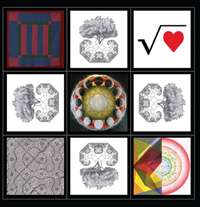
Rhythm of Structure is a multimedia interdisciplinary project founded in 2003. It features a series of exhibitions, performances, and academic projects that explore the interconnecting structures and process of mathematics and art, and language, as way to advance a movement of mathematical expression across the arts, across creative collaborative communities celebrating the rhythm and patterns of both ideas of the mind and the physical reality of nature.
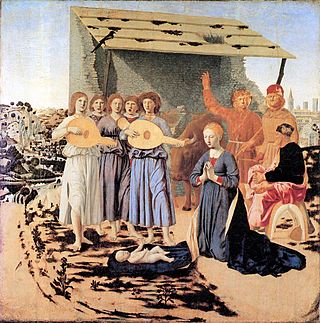
The Nativity is an oil painting by Italian Renaissance artist Piero della Francesca, dated to 1470–75. The painting depicts a scene from the birth of Jesus, and is one of the latest surviving paintings made by the artist before his death in 1492. Held by the National Gallery in London, it measures 124.4 cm × 122.6 cm. It is a popular image on Christmas cards.

Perspectiva corporum regularium is a book of perspective drawings of polyhedra by German Renaissance goldsmith Wenzel Jamnitzer, with engravings by Jost Amman, published in 1568.

De quinque corporibus regularibus is a book on the geometry of polyhedra written in the 1480s or early 1490s by Italian painter and mathematician Piero della Francesca. It is a manuscript, in the Latin language; its title means [the little book] on the five regular solids. It is one of three books known to have been written by della Francesca.

























